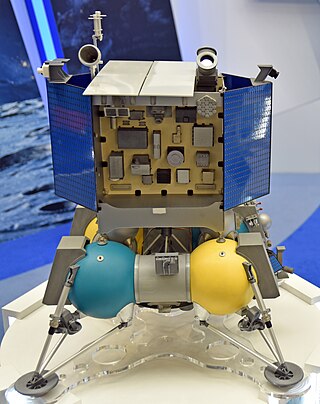Top Qs
Timeline
Chat
Perspective
Luna 27
Planned Russian lunar lander From Wikipedia, the free encyclopedia
Remove ads
Luna 27 (Luna-Resurs 1 lander or Luna-Resource-1 lander)[3][4] is a planned lunar lander mission by the Roscosmos to send a lander to the South Pole–Aitken basin, an area on the far side of the Moon.[5][4][6] Its objective will be to detect and characterise lunar polar volatiles. The mission is a continuation of the Luna-Glob programme.[5]
Remove ads
Mission
The purpose is to prospect for minerals, volatiles (nitrogen, water, carbon dioxide, ammonia, hydrogen, methane and sulfur dioxide), and lunar water ice in permanently shadowed areas of the Moon and investigate the potential use of these natural lunar resources.[5] On the long term, Russia considers building a crewed base on the Moon's far side that would bring scientific and commercial benefits.[5]
The lander mission was announced in November 2014 by Russia,[7] and its launch is planned for 2028.[1]
Remove ads
Science payload
The lander will feature 15 science instruments that will analyse the regolith, plasma in the exosphere, dust, and seismic activity.[8][needs update]
Planned collaboration with ESA
Summarize
Perspective
Europe's participation in the mission received final approval at a meeting of ministers in December 2016. European Space Agency (ESA) planned to contribute with the development of a new type of automated landing system,[9] and by providing the 'PROSPECT' package, consisting of a drill (ProSEED), sample handling, and an analysis package (ProSPA).[10][11][12] The percussion drill is designed to go down to 2 m (6 ft 7 in) and collect cemented ice samples for an onboard miniaturised laboratory called ProSPA.[5][10]
The ESA payloads under collaboration with Russia was planned to fly Package for Resource Observation and in-Situ Prospecting for Exploration, Commercial exploitation and Transportation (PROSPECT) program's ProSEED lunar sampling drill, ProSPA chemical laboratory and volatile analysis package and Exospheric Mass Spectrometer L-band (EMS-L) high-performance communications payload on this mission,[13][14] but the ProSEED and ProSPA will now fly on a NASA Commercial Lunar Payload Services mission in 2025 and the EMS-L will now fly on JAXA/ISRO's LUPEX lunar rover mission in 2026[15][16] due to international collaboration being cancelled after the 2022 Russian invasion of Ukraine.[17][18]
See also
References
External links
Wikiwand - on
Seamless Wikipedia browsing. On steroids.
Remove ads

